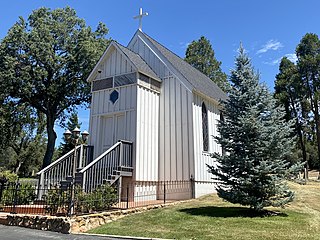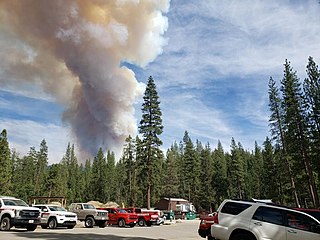
Madera County, officially the County of Madera, is a county located at the geographic center of the U.S. state of California. It features a varied landscape, encompassing the eastern San Joaquin Valley and the central Sierra Nevada, with Madera serving as the county seat. Established in 1893 from part of Fresno County, Madera County reported a population of 156,255 in the 2020 census.

Madera is a city and county seat of Madera County, located in the San Joaquin Valley of California. As of the 2020 United States census, the city's population was 66,224.

Oakhurst is a census-designated place (CDP) in Madera County, California, United States, 14 miles (23 km) south of the entrance to Yosemite National Park, in the foothills of the Sierra Nevada. At an elevation of 2,274 ft (693 m), Oakhurst is situated at the junction of Highway 41 and Highway 49, marking the southern end of California's Gold Country. It is part of the Madera metropolitan statistical area.

Nelder Grove, located in the western Sierra Nevada within the Sierra National Forest in Madera County, California, is a Giant sequoia grove that was formerly known as Fresno Grove. The grove is a 1,540-acre (6.2 km2) tract containing 60 mature Giant Sequoia trees, the largest concentration of giant sequoias in the Sierra National Forest. The grove also contains several historical points of interest, including pioneer cabins, giant sequoia stumps left by 19th-century loggers, and the site where the Forest King exhibition tree was felled in 1870 for display.

Ahwahnee is a census-designated place in Madera County, California, United States. It is located 5.25 miles (8.4 km) west of Yosemite Forks, at an elevation of 2,326 feet (709 m). The population was 2,296 at the 2020 census.
KVPT is a PBS member television station in Fresno, California, United States, owned by Valley Public Television, Inc. Its studios are located on Van Ness Avenue and Calaveras Street in downtown Fresno, and its transmitter is located on Bear Mountain, near Meadow Lakes, California. It is also broadcast in Bakersfield on translator K18HD-D.
Berenda was an unincorporated community in Madera County, California. It is located on the north bank of Berenda Creek 3.3 miles (5.3 km) southeast of Fairmead, and 7 miles (11 km) northwest of Madera, at an elevation of 253 feet (77 m). Berenda is located on the Southern Pacific Railroad.
Indian Lakes Estates is an unincorporated community in Madera County, California. It borders the Chukchansi Gold Resort and Casino to the east, and is south of Coarsegold. As of 2000, it was a wooded enclave of 485 homes to working families and retirees, using the two-lane Road 417 as their main residential road. It lies at an elevation of 2247 feet.

Nipinnawasee is a census-designated place in Madera County, California, United States. It is located 1 mile (1.6 km) southeast of Miami Mountain in the Sierra Nevada, 14 miles (22.5 km) southeast of Mariposa, at an elevation of 2,930 feet (890 m). The population was 434 at the 2020 census.
Sumner Hill is an unincorporated community in Madera County, California. Lying at an elevation of 535 feet, it is 6+1⁄2 miles north of Woodland Park in Fresno. It was created in 1985 as a 49-lot subdivision on a bluff on the eastern section of Peck Ranch, on the Madera County side of the San Joaquin River. The gated community developed a reputation for its high-priced homes. In the 1990s, the entire 15,000-acre area south of Little Table Mountain and east of Highways 41 and 45, including Sumner Hill, started being called "Rio Mesa".

The Rough Fire was a major wildfire in Fresno County, California, and the largest of the 2015 California wildfire season. The fire was ignited by a lightning strike on July 31 and burned 151,623 acres (61,360 ha), largely in the Sierra National Forest and the Sequoia National Forest, before it was declared contained on November 6, 2015. At the time it occurred, the fire was the thirteenth largest in recorded California history.

The Mineral Fire was a wildfire that burned in Coalinga Mineral Springs, west of Coalinga in Fresno, California in the United States. The fire was first reported on July 13, 2020 and burned an estimated 29,667 acres (12,006 ha) and before being fully contained on July 26. The fire threatened the communities of Los Gatos Creek Road from Indian Springs to Union Carbide Road and Bingham Springs. It resulted in the mandatory evacuations of Los Gatos Creek Road and Bingham Springs and led to the complete closure of State Route 198 from Firestone Ave. to the Monterey County Line. They were subsequently lifted on July 20.

The 2020 Creek Fire was a very large wildfire in central California's Sierra National Forest, in Fresno and Madera counties. One of the most significant fires of California's record-setting 2020 wildfire season, it began on September 4, 2020, and burned 379,895 acres (153,738 ha) over several months until it was declared 100% contained on December 24, 2020. The Creek Fire is the sixth-largest wildfire in recorded California history and the third-largest single fire—i.e. not part of a larger wildfire complex—following the 2021 Dixie Fire.

The SQF Complex fire—also called the SQF Lightning Complex—was a wildfire complex that burned in Tulare County in Central California in 2020. Comprising the Castle and Shotgun fires, it affected Sequoia National Forest and adjacent areas. Both fires began on August 19, 2020, and burned a combined total of 175,019 acres before the complex as a whole was declared 100 percent contained on January 6, 2021. In the course of the fires, 232 structures were destroyed. There were no fatalities.

The Washburn Fire was a wildfire that burned in Yosemite National Park near the Mariposa Grove of giant sequoias. The fire was reported on July 7, 2022, in the lower Mariposa Grove area near the Washburn trail, for which the fire is named. The fire quickly attracted national attention due in part to the role the Mariposa Grove played in the establishment of Yosemite National Park and the National Park Service.

The Oak Fire was a destructive wildfire in Mariposa County and the Sierra National Forest in Central California during the 2022 California wildfire season. The fire was reported on July 22, 2022, and burned 19,244 acres (7,788 ha) before being fully contained on September 2, 2022. On June 16, 2023, a 71-year-old man was arrested on suspicion of arson for starting the fire.

The 1992 Fountain Fire was a large and destructive wildfire in Shasta County, California. The fire ignited on August 20 in an act of probable but unattributed arson, and was quickly driven northeast by strong winds. It outpaced firefighters for two days, exhibiting extreme behavior such as long-range spot fires, crown fire runs, and pyrocumulonimbus clouds with dry lightning. The fire was contained after burning for nine days, though work to strengthen and repair fire lines continued for more than two months.

The 49er Fire was a destructive wildfire in 1988 in Northern California's Nevada County and Yuba County. The fire ignited on September 11 when a man accidentally set brush on fire by burning toilet paper near Highway 49. Driven by severe drought conditions and strong, dry winds, firefighting crews were hard-pressed to stop the fire's advance until winds calmed and humidity levels recovered. The fire burned 33,700 acres throughout the foothills of the Sierra Nevada, impinging on the communities of Lake Wildwood, Rough and Ready, and Smartsville before officials declared it fully contained on September 16.

According to California Department of Forestry and Fire Protection statistics, 7,622 wildfires burned a total of 295,026 acres in the US state of California in 2000. Cal Fire wildfire suppression costs for fires that burned within the agency's jurisdiction amounted to $109 million. Damages for the same amounted to $87.3 million, with a total of 389 structures lost. The largest wildfires of the year in California were the Manter and Storrie fires, which burned 74,000 and 55,000 acres in Tulare and Plumas counties respectively.

The Telegraph Fire was a destructive wildfire in Mariposa County, Central California, in the summer of 2008. After it was unintentionally ignited by a target shooter on July 25, the fire burned 34,091 acres in the foothills of the Sierra Nevada west of Yosemite National Park before it was declared fully contained on August 6. The Telegraph Fire destroyed 20–30 homes and dozens of outbuildings and impacted tourism in the Yosemite Valley and adjacent areas. No fatalities occurred; dozens of firefighters sustained minor injuries during the fire suppression effort.



















